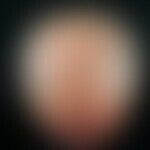Synonym(s)
DefinitionThis section has been translated automatically.
Most common type of hair loss realized by androgens in men and women. Emergence of the genetically determined characteristic pattern of the hair coat. Frequently accompanying seborrhoea (hence also Alopecia oleosa, Alopecia seborrhoica).
Occurrence/EpidemiologyThis section has been translated automatically.
Prevalence in European men up to 80%; prevalence in Asian & African men low.
You might also be interested in
EtiopathogenesisThis section has been translated automatically.
- Associations with polygenic hereditary factors are discussed, which are unknown so far. Genes involved in androgen-hair follicle interaction are likely. Described in connection with alopecia are, among others, the hairless gene (see also Alopecia congenitalis universalis) and the androgen receptor gene (AR gene), which is localized on region Xq12-22 of the X chromosome. Possible associations with A. androgenetica are still controversially discussed.
- The interaction of genetic predisposition and hormonal manifestation factors leads to shortening of the anagen phase and miniaturization of hair follicles with vellus hair formation ("regressive metamorphosis"). Due to genetic predisposition, hair follicles express DHT receptors. Natural ligand of these receptors is DHT (dihydrotestosterone), which is formed by conversion of testosterone to DHT by the enzyme 5α-reductase. 2 isoenzymes of 5α-reductase are known: type 1 and type 2 (predominated in hair follicles of scalp & beard). Intracellular binding of DHT to DHT receptors results in the alteration of the androgen-receptor complex, which is transported to the nucleus and acts as a transcription factor. The distribution of androgen-metabolizing enzymes (5α-reductase type 1 u. 2, aromatase, hydroxysteroid dehydrogenase) is possibly responsible for the expression of androgenetic alopecia. In males, a 1.5-fold higher activity of androgen-metabolizing enzymes has been demonstrated frontally.
- Secondary factors (associations are controversial!):
- Seborrhea
- Cholesterol accumulation in the scalp (5α-reductase expression from cholesterol after contact with sunlight in the scalp!).
- Circulatory disorders in the scalp.
ManifestationThis section has been translated automatically.
Variable, usually before the 40th LJ; first signs often already after puberty, usually in the 3rd decade of life. Maximum in the 4th decade.
ClinicThis section has been translated automatically.
Variable clinic according to the stage of the disease:
- Stage I: Normal hair pattern.
- Stage II: receding of the forehead-hair borders, especially at the temples with formation of receding hairline.
- Stage III: Tonsure-like, occipitoparietal hair thinning with existing hair bridge.
- Stage IV: Almost complete loss of hair in the parietal region; remaining lateral and posterior hair crown.
- Stage V: Thin occipital and parietal crown-shaped hair.
HistologyThis section has been translated automatically.
DiagnosisThis section has been translated automatically.
Complication(s)(associated diseasesThis section has been translated automatically.
TherapyThis section has been translated automatically.
Remember! Treatment should be started as early as possible to stop irreversible follicular regression!
Guidelines: 5% minoxidil solution or foam, internally 1 mg finasteride per day as a tablet. In the absence of success, 0.5 mg dutasteride per day.
Furthermore, if sufficient donor hair is available, hair transplantation by appropriately specialized surgeons can be recommended.
Currently, successes have been described with low level laser therapy and injections of platelet-rich plasma from autologous blood (PRP). Controlled clinical studies are still lacking for the latter two procedures.
General therapyThis section has been translated automatically.
In the case of a pronounced desire for therapy, detailed counseling and information about possible therapy options. It is important to dampen the usually too high expectations of a successful therapy. The primary goal of treatment is to stop the progression of hair loss.
Reminder. Important for all therapy approaches: Therapy successes can only be expected after several weeks to several months of application.
Therapy with Platelat-rich plasma (PRP) shows good results.
Soft lasers, which work with long-wave red light, can also stimulate hair growth.
External therapyThis section has been translated automatically.
ApplyMinoxidil 5% solution (e.g. Regaine 5%, Lonolox) 2 times/day to the affected areas. Continuous therapy required, as hair loss recurs in men after discontinuation, about 3 months later.
Caffeine-containing topicals: In vitro and penetration studies on the effect of caffeine on the hair follicle demonstrate penetration and accumulation of topical caffeine (Otberg N et al. 2008). However, penetration and accumulation are not synonymous with stimulation (Dressler C 2017).
Smaller predominantly positive studies exist on combinations of caffeine+minoxidil (Golpur et al 2013), caffeine (1.5%)+minoxidil (5%)+azelaic acid (1.5%) (Pazoki-Tourodi et al 2013).
Evidence on the effects of topical caffeine even in combination with other agents such as minoxidil and aelainic acid at the hair root is currently insufficient (Fischer TW et al. 2014). The European S3 guideline for the treatment of AGA mentions caffeine as a treatment option, but does not give an indication for treatment due to lack of evidence (cited in Dressler C 2017).
Thymuskin is reported to have shown a beneficial effect on hair growth in small study cohorts.
Finasteride locally as a spray at a dosage of 2.275 mg/ml for men with mild to moderate alopecia androgenetica (age range 18-41 years). Dosage starting with 1 Srpühstoß/day and daily increase by 1 spray up to 4 sprays / day on the light areas.
Internal therapyThis section has been translated automatically.
- Finasteride (e.g. Propecia®: 4-azasteroid = selective 5-alpha-reductase-type 2-inhibitor) 1 time a day 1 mg p.o. for at least 6 months ( off-label use; finasteride is available only on prescription but not reimbursable). Studies comparing finasteride with minoxidil show a significantly superior efficacy of finasteride (Arca E et al. 2004). It has been shown that finasteride is a long-term therapy approach (>6 months). Patients should be informed that possible therapeutic success will decrease if the therapy is discontinued.
- Alternatively, dutasteride (e.g. Avodart, selective 5-alpha-reductase type I and type 2 inhibitors): once/day 0.5 mg p.o. for at least 6 months ( off-label use).
- Please note the possible side effects caused by the antiandrogenic effect.
- Nicotinic acid p.o. (e.g. Nicobion Tbl.) and vitamin B-complex (withoutB1) can be used as support.
Operative therapieThis section has been translated automatically.
If necessary, transplantation of mini- or micrografts from the occipital parts of the head, see hair transplantation. Donor dominance, micrografts 1-2 hairs, minigrafts 3-5 hairs. After 3-6 months normal growth should occur.
Notice! Artificial hair transplants are obsolete because of foreign body reactions!
NaturopathyThis section has been translated automatically.
Currently, further studies are expected in male androgenetic alopecia with extracts of green tea (epigallocatechin-3-gallate), extracts of saw palmetto fruit (Serenoa repens) as well as Citrullus colocynthis and Cuscuta reflexa (Rondanelli M et al. 2016).
Note(s)This section has been translated automatically.
LiteratureThis section has been translated automatically.
- Bader U, Trueb RM (2002) Androgenetic alopecia in the man. Ther Umsch 59: 211-216
- Dressler C (2017) Efficacy of topical cocffeine in male androgenetic alopecia. J Dtsch Dermatol Ges 15: 734-741.
- Feldmann KA et al (2002) Recent therapeutic progress in alopecia and hypertrichosis. Dermatol 53: 293-295
- Pazoki-Toroudi H et al. (2013) The efficacy and safety of minoxidil 5% in combination with azelaic acid 1/5% and caffeine 1% solution on male pattern hair loss. Journal Investigative Dermatology 2013; 133: Suppl 1.
- Hanneken S et al (2003) Androgenetic alopecia. Current aspects of a familiar phenotype Dermatologist 54: 703-712.
- Hillmer AM et al (2005) Genetic variation in the human androgen receptor gene is the major determinant of common early-onset androgenetic alopecia. Am J Hum Genet 77: 140-14811
- Hoffmann R (2002) TrichoScan. A new instrument for digital hair analysis. Dermatologist 53: 798-804
- Paus R, Cotsarelis G (1999) The biology of hair follicles. N Engl J Med 341: 491-497
- Price VH (1999) Treatment of hair loss. N Engl J Med 341: 964-973
- Prieto VG et al (2002) Androgenetic alopecia: analysis of proliferation and apoptosis. Arch Dermatol 138: 1101-1102
- Rondanelli M et al. (2016) A bibliometric study of scientific literature in Scopus on botanicals for treatment of androgenetic alopecia. J Cosmet Dermatol 15:120-130.
- Leavitt M et al. (2009) HairMax LaserComb laser phototherapy device in the treatment of male androgenetic alopecia: A randomized, double-blind, sham device-controlled, multicentre trial. Clin Drug Investig. 29:283-292.
- Gentile P et al. ( 2020) Review of Platelet-Rich Plasma Use in Androgenetic Alopecia Compared with Minoxidil®, Finasteride®, and Adult Stem Cell-Based Therapy. Int J Mol Sci. 13;21:2702
- Sharma A et al (2021) Platelet-Rich Plasma in Androgenetic Alopecia. Indian Dermatol Online J. 12 (Suppl1): 31-40.
- https://www.haarerkrankungen.de/aktuelles/haarsinglenewsmeldung.php?newsid=20180222
- Finner AM (2022) Hair transplantation- sustainable medical planning and implementation. Dermatologist 73:358-368
- https://www.ema.europa.eu/en/documents/pip-decision/p/0113/2016-ema-decision-15-april-2016-granting-product-specific-waiver-finasteride-emea-001878-pip01-15_en.pdf
Incoming links (29)
Acquired progressive hair curvature; Acromegaly; Alopecia androgenetic; Alopecia androgenetica in women; Alopecia oleosa; Alopecia praematura; Alopecia seborrhoica; Antiandrogen-oestrogen combinations; Bald forehead; Balding, male; ... Show allOutgoing links (14)
Coffein; Dutasteride; Finasteride; Hair transplantation; Low level laser therapy; Minoxidil; Off-label use; Platelat-rich plasma (PRP) ; Saw palmetto; Seborrhoea; ... Show allDisclaimer
Please ask your physician for a reliable diagnosis. This website is only meant as a reference.













